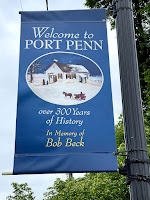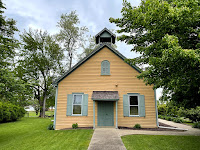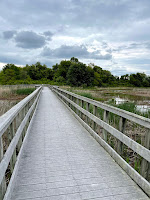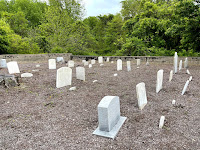For such a tiny town in such a tiny state, Port Penn has an enormous amount of history. As I explored the area, I was surprised by how rich this town's past is. Even better, the town is doing everything it can to preserve it.
The Dutch had a settlement here as far back as 1640. They managed to hold onto it even after the English took over the Dutch colonies. In 1682, William Penn stopped here for some water and the settlers were so honored that they named their settlement Port Penn.
By the 1760s, the town had been taken over by David Stewart who decided he was going to build a port city to rival Philadelphia. Unfortunately, the railway bypassed the town as did the subsequent canal. By the 1830s, this town had become a farm community as well as a fishing village.
Over the years, the inhabitants survived by living off the land, hunting, fishing, and trapping. It wasn't until the 1960s that the people who live here started looking outside the town for jobs. Now, it is a community that prides itself on its past and will proudly show you why.
Start your visit with a stop at the Port Penn Interpretive Center. The state of Delaware has taken over some of the town as a state park and this is its base of operations.
Originally the town schoolhouse, the Center is worthy of a look around. In 1975, in anticipation of the bicentennial, the town leaders went door to door to ask residents if they had anything stored in their attics that they might want to donate for a local exhibit about the town. It turned out that there was a treasure trove of goodies; so good, in fact, that the town kept the small museum for many years.
Eventually, they ran out of money and went looking for someone to step in. The state of Delaware came to the rescue and by creating the state park was able to protect the building and all the items inside. It doesn't take long to walk around and you will see all kinds of really fun things from many, many years ago.
When you have seen everything in the Interpretive Center, it is time for a walk. The Port Penn Wetlands Trail is right by the Center.
You will go through the marsh that sustained the town's inhabitants for generations. As Stewart's plan become less and less of a reality, survival became the name of the game. The town's residents hunted, fished, and trapped not only to eat but to sell. Each season brought another animal that they would look for and so they survived until the middle of the 20th century. At that point, the younger people began to leave the town looking for work. There are still people in the town, however, who attended that school house and who remember being told by their mother that if they wanted dinner, they needed to go hunt for it. They would come home with something very easily.
The trail is a lovely place for a walk and it is very flat, easy, and short. As I walked across this boardwalk, I was transported to what this land must have looked like before humans took over. The marsh is filled with wildlife, and the sounds as you walk are as soothing as anything you can imagine.
Just before you get onto the boardwalk, you will come across an old, white shack. Take a good look because you do not see these often. This is a floating shack. Literally, they were built to float on the marsh and would contain a bed, a table, a stove to heat the place, and that's about it. The locals would stay in these while they were trapping and would use them to skin what they caught.
As you come off the boardwalk, you will walk on grass and mud for a while until you see a disused deer stand. Take a right and before you know it, you are in the back end of town where you can begin your tour.
Now is your opportunity to Explore the Town. The town tour you picked up from the Center and the tour outlined on the placards aren't exactly in sync. But, no matter. The town is small enough that even if you have to backtrack once or twice, it won't be for more than a block or so.
What you will discover as you walk around is that pretty much every house in the town is on the national register. Some are beautifully kept up; others less so. The oldest house in town is David Stewart's built in 1740. Many of the houses were built in the 19th century, but one of the most interesting was built in 1915. It was ordered from Sears, shipped in boxes, and built on site. Sears beats Amazon!
The most interesting story is about the two churches shown here. The one above is the Presbyterian church, originally built for the white people in town. The one on the right is the Methodist church built for the people of color. Although both have been fully integrated for many years, the Presbyterian church did not survive COVID and has shut down. The other church, smaller and not in the center of the town, has survived with its congregation intact.
Keep following the tour and you will eventually end up back at the Interpretive Center. It is now time to make your way down the street to the Stewart Cemetery.
David Stewart (son of the original) bought this piece of land outside of town for his family to be buried. Burials occurred here from 1789 until 1944. Most of the names are Stewart, but there are some others in the plot. Town historians are relatively certain that they were all families that married into the Stewarts.
As so often happens with cemeteries this old, one is struck by the sheer number of children who did not survive their first year. In the days before vaccinations and antibiotics, it didn't take much and it is heartbreaking to see so many tiny stones with just initials on them.
After all this walking around, you might be feeling a tad peckish. There is only one place to eat in town. There has been an inn/tavern on the site where Kelly's Tavern stands today for almost as long as the town has existed. While the outside looks like an old tavern, the inside looks less so. There is a long bar and tables, but it has an up to date feel about it.
As I was there for lunch, I was not able to have crabs, the house specialty. Because it was cold and had started to rain by the time I walked in, I ordered a cup of the snapper soup as the turtles in question used to be one of the animals hunted in the swamp. The soup was very good, slightly spicy and served piping hot. My only complaint was that it was a tad on the salty side. I followed that up with a soft shell crab. Disappointing. The crab had been frozen and the breading was really bland. The homemade iced tea, however, was a treat.
I recommend Port Penn for a day's outing. There is a lot to see, some great walking, a lot of history to learn, and some good food at the end of it all.
LOGISTICS:
Port Penn is located south of Delaware City and east of the Canal right on the Delaware River. Finding your way to the Interpretive Center is a bit tricky. Put Port Penn into your GPS and you will most likely come into town on Market Street. Keep your eyes peeled for Liberty Street. The Interpretive Center is on that corner on the left as you are driving into town. There is plenty of parking. Before you leave the Center, have a good look around and don't forget to pick up a map of the town walk.
To get to the Wetlands Trail from the Center, walk out the door and look to the left. You will see the sign showing the trailhead. It couldn't be easier to follow. Just watch out for the deer stand where you will take a right to get into town.
The town is laid out on a grid and is very easy to walk around. The map tour and the tour on the placards aren't identical, but you will be able to follow both very easily.
Kelly's Tavern is about halfway through the town walk. I decided to finish my touring and then go back to the tavern when I was finished, but if you have hungry members of your party, halfway might be a good time to stop.
Once you get back to the Interpretive Center, use your car to get to the Stewart Cemetery. Turn right onto Market Street and in about a quarter mile, you will see a brown sign pointing right. Follow it, even though it looks as though you are driving into someone's driveway (which, you are). Follow the signs and they will take you right where you want to go.
One final reminder. Most of the houses you will see are owned by real people. Please do not take photographs or stare overlong without the owner's permission.
Port Penn
Intersection of Market Street and Liberty Street
Port Penn, DE
302-836-2533










No comments:
Post a Comment